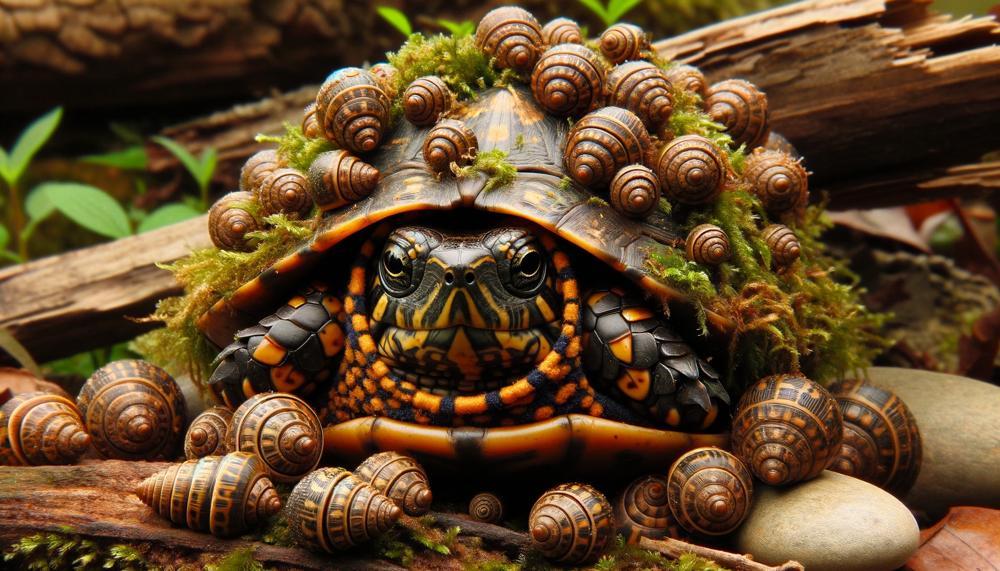As the chill of winter settles in, many animals begin to prepare for a long period of hibernation. While bears and groundhogs may come to mind, there is one creature that also enters a deep slumber during the colder months: the box turtle.
But what exactly is hibernation, and how does it work for these slow-moving reptiles? Let’s delve into the intriguing world of box turtle hibernation with these key points:
- Box turtles are ectothermic creatures, meaning they rely on external sources of heat to regulate their body temperature.
- As temperatures drop, box turtles start to slow down and become less active.
- They seek out a suitable spot, such as under logs or in burrows, and burrow themselves into the ground.
- During this time, their metabolism slows significantly, allowing them to conserve energy and survive without food for several months.
- In fact, box turtles can remain in this state of hibernation for up to six months.
- When spring arrives and temperatures rise again, they emerge from their slumber and resume their normal activities.
Join us as we embark on a journey through the brumation process of these captivating creatures and discover how they brave the harsh winter months.
Contents
- 1 Do Box Turtles Hibernate Brumation Process?
- 2 Understanding the Natural Habitat and Behaviors of Box Turtles
- 3 Factors That Influence Brumation in Box Turtles
- 4 The Process of Brumation for Box Turtles
- 5 Maintaining Proper Care for a Brumating Box Turtle
- 6 Common Misconceptions About Box Turtle Brumation
- 7 Preparing for and Monitoring the End of Brumation
- 8 Conclusion
Do Box Turtles Hibernate Brumation Process?
The process of brumation for box turtles is a period of deep sleep that they enter during the colder months. It is similar to hibernation, but has distinct differences.
Unlike hibernation, where animals enter a state of prolonged rest and do not wake up until spring, box turtles will sometimes awaken and move around during brumation.

This allows them to regulate their body temperature and remain hydrated. Brumation also varies from hibernation in terms of duration, level of activity, and physiological changes that occur.
While hibernation can last for several months uninterrupted, brumation may only last for shorter periods of time and box turtles are still somewhat alert and able to move around if necessary.
Additionally, while animals in hibernation experience a decrease in body temperature, heart rate, and breathing rate, box turtles do not undergo these same changes during brumation.
Instead, their metabolism slows down to conserve energy, but their body temperature and heart rate remain relatively stable.
Understanding the Natural Habitat and Behaviors of Box Turtles
Box turtles have two primary survival tactics during the colder months of the year: hibernation and brumation. During hibernation, these turtles enter a state of torpor, slowing down their heart rate and breathing to conserve energy.
Conversely, in brumation, they remain active but at a slower pace. These behaviors are essential for box turtles to survive in the wild, as they allow them to conserve energy and stay warm during the harsh winter months.
Interestingly, box turtles have the ability to choose when to hibernate or brumate based on environmental cues. This instinctual ability helps them find suitable shelter for this period, ensuring their survival in the face of changing weather conditions. These adaptations have been crucial for their survival for millions of years in their natural habitat.
But what exactly is the difference between hibernation and brumation? Hibernation is a state of deep sleep where animals significantly reduce their metabolism and bodily functions. This allows them to conserve energy and survive in harsh conditions.
On the other hand, brumation is a state of reduced activity where animals slow down their metabolism but remain somewhat active. This allows them to move around and forage for food when necessary.
Box turtles’ ability to enter both hibernation and brumation is truly remarkable. It highlights their resilience and adaptability to survive in challenging environments.
Factors That Influence Brumation in Box Turtles
Box turtles possess the remarkable ability to enter a state of dormancy called brumation during the colder months, which is vital for their survival.
The factors that influence this process in box turtles include temperature, food availability, humidity levels, light exposure, noise levels, as well as the age and health of the turtle. It is essential to carefully consider and manage these factors when caring for box turtles to ensure a successful brumation process.
Temperature plays a crucial role in the brumation process. Box turtles require a specific range of temperatures to enter and maintain brumation. If the temperature falls too low, they may not enter brumation at all, while a higher temperature can cause them to wake up prematurely. Therefore, it is important to monitor and control the temperature in their environment.
Another important factor is food availability. Box turtles feed heavily before entering brumation and then rely on stored fat reserves during this period. If food is scarce or inadequate before brumation, it can lead to health issues or even death. On the other hand, overfeeding before brumation can also pose a risk as it can cause obesity and other health problems.
Humidity levels are also crucial for a successful brumation process. Box turtles require high humidity levels to ensure proper hydration and respiratory function during dormancy. If humidity levels are too low, it can lead to dehydration and other health complications.
Light exposure can also impact the brumation process in box turtles. These reptiles require low light levels during dormancy, so it is important to keep their environment dimly lit. Exposure to bright lights can cause them to wake up prematurely or disrupt their sleep patterns.
Noise levels can also affect box turtles during brumation. These creatures are sensitive to noise and can be easily disturbed by loud sounds or vibrations. Therefore, it is important to keep their environment quiet and peaceful during this time.
Lastly, the age and health of the turtle also play a significant role in the brumation process. Young or unhealthy turtles may not have enough fat reserves to sustain them through brumation and may require special care and monitoring.
The Process of Brumation for Box Turtles
Brumation is a state of dormancy observed in reptiles and amphibians, such as box turtles, during colder months. This process is similar to hibernation in the sense that it helps these animals conserve energy and survive through harsh conditions. However, there are notable differences between the two, including duration, activity level, and physical changes.
Unlike hibernating mammals, box turtles do not enter into a deep sleep during brumation and may still move around their habitats.
Additionally, their body temperature remains relatively stable, and they have the ability to wake up from brumation if necessary. Understanding these differences allows us to better care for box turtles during their periods of dormancy.
| Brumation | Hibernation | Comparison |
| Occurs in reptiles and amphibians | Occurs in mammals | Brumation is often referred to as “reptile hibernation” |
| Lasts for a few weeks at a time | Lasts for months at a time | Brumation has a shorter duration compared to hibernation due to lower energy requirements in reptiles. |
| Body temperature remains relatively stable | Body temperature decreases significantly | The decrease in body temperature during brumation is not as drastic as in hibernation for box turtles. |
| May still move around and wake up if necessary | Remains completely inactive and cannot be easily awoken | Box turtles have the ability to be more active and responsive during brumation compared to hibernating mammals. |
| Heart rate and breathing rate may decrease to conserve energy | Heart rate and breathing rate decrease significantly | Both processes involve a decrease in heart and breathing rates, but the level of decrease is more drastic in hibernation. |
Understanding the differences between brumation and hibernation is crucial when caring for box turtles during their dormant periods. While brumation can last for a few weeks at a time, hibernation can span over several months.
Box turtles do not experience a drastic decrease in body temperature during brumation, unlike hibernating mammals. This allows them to still move around and wake up if necessary.
Moreover, their heart and breathing rates may decrease to conserve energy, but not as significantly as in hibernation. These unique characteristics of brumation make it more complex and intriguing compared to hibernation.
Maintaining Proper Care for a Brumating Box Turtle
| Maintaining Proper Care for a Brumating Box Turtle | Understanding Brumation |
| What is Brumation? | Before we dive into the key factors of caring for a box turtle during brumation, it’s critical to understand what brumation is and how it differs from hibernation. |
| Preparing Your Turtle | Ensuring your turtle is in optimal health before entering brumation is crucial. This includes keeping an eye on their food and water intake and addressing any underlying health issues that could impact their survival during this period. Additionally, providing a suitable place for them to hibernate, such as a burrow or hibernaculum, is essential. |
| Temperature Maintenance | While box turtles do not drastically lower their body temperature during brumation, it’s still crucial to maintain a cool environment for them. The ideal temperature for brumation is around 50-60 degrees Fahrenheit. Keeping track of the temperature is vital to the success of your turtle’s brumation process. |
| Hydration | During brumation, it’s essential to provide your turtle with access to shallow water or regularly mist their enclosure to keep them hydrated. This will help prevent dehydration, which can be dangerous for the turtle’s health. |
| Regular Monitoring | It’s crucial to keep a close eye on your turtle’s weight, hydration levels, and overall health during brumation. Regularly checking on them will allow you to address any issues that may arise promptly and ensure their well-being. |
| Allowing Natural Cycle | It’s essential to allow your turtle to go through the full brumation cycle naturally without interruption. This will help them maintain their natural instincts and behaviors during this period. |
| Post-Brumation Care | After brumation, it’s crucial to gradually warm up your turtle and reintroduce food and water. Monitor their health and weight closely, as they may need some time to adjust back to their regular routine. |
Common Misconceptions About Box Turtle Brumation
| Misconception: | Correction: |
| Box turtles do not experience brumation. | While this may be true for indoor pets that do not encounter environmental changes, brumation is a natural process crucial for the reproductive and overall health of turtles. |
| Brumation is not essential for the well-being of box turtles. | In fact, brumation plays a pivotal role in regulating hormones and preventing illnesses in turtles. It is a vital part of their natural cycle and should not be disregarded. |
| Turtles do not require any special care during brumation. | This is false, as proper preparation and monitoring are necessary for the health of brumating turtles. Owners should consult with a veterinarian and provide appropriate care, such as routine soaking and weight checks, to ensure their pet’s well-being. |
| Turtles can safely undergo brumation outdoors. | However, brumating outdoors can be hazardous due to extreme temperatures and predators. Owners should provide an indoor alternative during extreme weather to protect their pet. |
| All box turtles should experience brumation. | Sick or injured turtles, as well as those under 4 years old, should not undergo brumation. They can be housed indoors with appropriate light and temperature instead to ensure their health. |
| Being a turtle owner automatically means you know how to care for your pet during brumation. | It is important for owners to educate themselves on their pet’s species and if they undergo brumation. Consulting with an exotic veterinarian is also recommended before initiating the brumation process. |
When it comes to box turtles, there are many common misconceptions surrounding their natural process of brumation. Some believe that they do not undergo this period of rest and inactivity, while others may think that it is not necessary for their health. However, these assumptions are not true and can have serious consequences for the well-being of turtles.
One common misconception is that box turtles do not experience brumation. While this may be true for indoor pets that do not experience environmental changes, brumation is a natural process crucial for the reproductive and overall health of turtles. It allows them to conserve energy during colder months and prepares them for successful reproduction in the spring.
Contrary to popular belief, brumation is not an unnecessary burden on turtles’ health. In fact, it plays a pivotal role in regulating hormones and preventing illnesses in turtles.
Preparing for and Monitoring the End of Brumation
In order to effectively prepare for and monitor the end of brumation in box turtles, it is imperative to take the following measures:
- Familiarize yourself with the specific species of turtle or tortoise you have, as well as their brumation habits.
- Ensure that your beloved pet has gained sufficient weight and is nutritionally fit for brumation, especially with foods high in Vitamin A.
- Schedule pre- and post-brumation physical exams with a veterinarian well-versed in reptile medicine.
- Keep a close eye on your pet’s weight loss during brumation, as excessive weight loss could be an indication of illness.
- Provide regular soaking to prevent dehydration, regularly monitor weight, and maintain a closely monitored environment during brumation.
- Consider providing an alternative indoor environment during extreme weather conditions to avoid freezing or exposure to predators.
- Consult with an exotic veterinarian before initiating brumation, as it can be hazardous if not done correctly.
- Do not allow sick or injured turtles or those under the age of four to undergo brumation. Instead, they should be housed indoors with appropriate lighting and temperature.
- Take responsibility for educating yourself on the nutritional needs and special care requirements for your pet.
These steps are essential for ensuring the safety and well-being of box turtles during their brumation period. By keeping yourself well-informed and consulting with a veterinarian, you can ensure that your pet is adequately prepared for and carefully monitored during this natural process.
Conclusion
In conclusion, the brumation process of box turtles is a remarkable survival mechanism that enables them to endure the harsh winter months. Unlike hibernation, where animals slip into a deep slumber and remain inactive until spring, box turtles enter a state of reduced activity and can awaken if needed.
This allows them to regulate their body temperature and maintain hydration levels. However, successfully navigating through brumation requires careful management of various factors such as temperature, food availability, humidity levels, light exposure, noise levels, and the age and health of the turtle. Understanding the nuances between brumation and hibernation is crucial when caring for these slow-moving reptiles during their dormant period.
As we observe these captivating creatures in their long winter slumber, let us also marvel at the intricacy and wonder of their unique brumation process. It serves as a testament to the resilience and adaptability of box turtles in their natural habitat.






